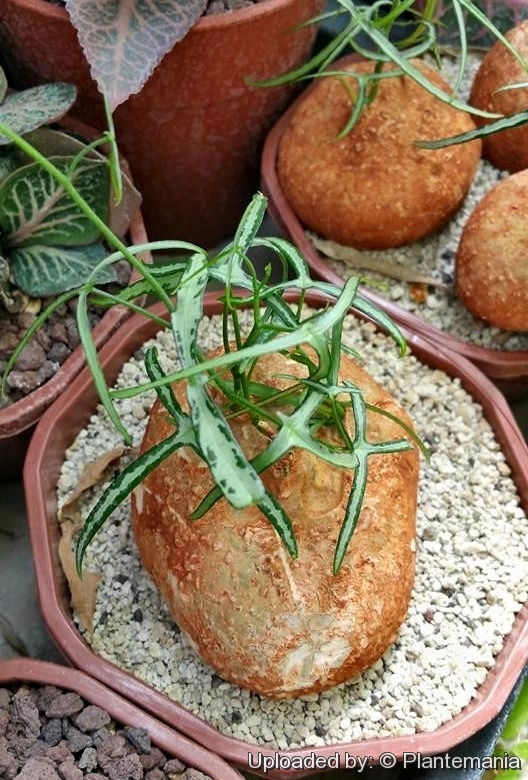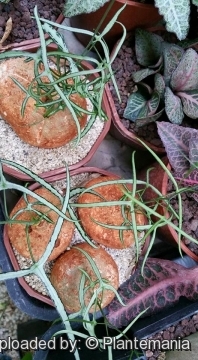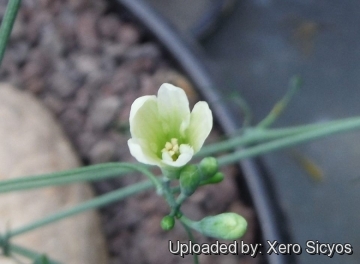




Your support is critical to our success.
Accepted Scientific Name: Adenia kirkii (Mast.) Engl.
Bot. Jahrb. Syst. 14: 375 1891.

Leaves of juvenile specimens are sometimes variegated and have a distinct peltate base.
Origin and Habitat: Costal Kenya, Eastern Tanzania, Zanzibar and Northern Mozambique.
Altitude range: 0–700 metres above sea level.
Habitat and Ecology: Forest, riverine forest, riverine thicket, thicket. Adenia kirkiiSN|33614]]SN|33614]] is threatened by habitat degradation due to smallholder agriculture conversion; charcoal burning and wood collecting; development of towns and recreation.
Synonyms:
- Adenia kirkii (Mast.) Engl.
- Modecca kirkii Mast.
Description: Adenia kirkiiSN|33614]]SN|33614]] is a herbaceous climber forming a tangle of twisted, often annual stems, to 3 m long, raying out every which way from an almost globular caudex up to 30 cm across. Male and female flowers are borne on separate plants. Pale yellow flowers open on the tendrils in the spring and summer. Leaves of juvenile specimens are sometimes variegated and have a distinct, up to 3 mm deep peltate base. Adenia kirkiiSN|33614]]SN|33614]] is characterized by a long, slender flower stipe (a stalk that elevates the male and female reproductive parts it supports beyond the corolla).
Caudex: The underground caudex (a storage stem, actually a distinctly swollen hypocotyl, the portion of the stem below where its cotyledons were attached and fell away in the seedling's infancy) is nearly globose up to 30 cm in diameter.
Branches. Often annual, slender, flexuose, angular, furrowed up to 3 m long.
Leaves: Membranous, 3-14 cm long, 2.5-13 cm broad, suborbicular in outline, base more or less cordate, deeply 3-5(-7)-foliolate. Leaflets entire linear-oblong, or (especially the middle ones) irregularly pinnately divided (up to 5-lobed), obtuse to acute 1?10 cm long, 0.5? 5(?7) cm wide, the basal leaflets directed towards the stem, green, sometimes variegated above, grey-glaucous beneath, covered or not on both surfaces with reddish, glandular dots, and with sessile glands in the axils of the nerves on the under surface. Reticulation indistinct, margin entire. Petiolule 0??25 mm long. Petiole 1?5 cm less than half the length of the blade thickened and decurrent at the base for a short distance along the stem, and provided at its apex with two large glands on the upper surface. Stipules linear, 1 mm long, withering. Tendril 2?6 cm long thickened at the end.
Inflorescences: Peduncle axillary, slender, terete, longer than the adjoining leaf, 1?6 cm cm long, bearing at the top a much-branched, many-flowered cyme (up to 15-flowered in male specimens, 1?4-flowered in female), the central branch of which ends in a tendril. Sterile tendrils up to 12 cm long.
Male flowers: Slender funnel-shaped 25?40 mm long (including the 15?25 mm long stipe). Flower-buds elliptic. Pedicels slender, longer than the flowers. Calyx funnel-shaped, limb 5-parted, calyx-lobes 5?6.5 mm long, imbricate, oblong-lanceolate, thinner at the edges where overlapped. Petals lanceolate or oblanceolate, 5?6.5 mm long, emerging from below the centre of the calyx-tube, membranous, 3-nerved, subentire, crenulate at the edges. Filaments 4?5 mm long, connate for about 1.5 mm, anthers 4.5?6 mm long, straight and free at their tops, protruding beyond the mouth of the calyx, linear. Staminodes or glands of the disk 5, short, liguliform, enclosed in membranous pouches. Pistil rudimentary.
Female flowers: Slender funnel-shaped 16?30 mm long (including the 8-15 mm long stipe) Hypanthium (comprising calyx tube) 2?6.5 mm long, 2?4 mm wide. Calyx-lobes ovate to oblong, 4?5 mm. Petals lanceolate to linear, 2.5?4.5 mm long, (1?)3-nerved. Staminodes 2?4 mm long, sometimes bearing abortive anthers, styles connate for 0.5?1 mm, style-arms 0.5?1 mm long, stigmas subglobose, 1.5?2 mm in diameter.
Fruits: 1(?2) per inflorescence, ovoid to ellipsoid 2?3.5 cm in diameter. Skin leathery.
Seeds: About 40 per capsule, obovate to nearly spherical, 5?5.5 mm long.
Bibliography: Major references and further lectures
1) J. G. Baker. “Flora of Tropical Africa”, Vol 2, 1871
2) W. J. J. O. de Wilde “Flora of Tropical East Africa”, Crown Agents, London, 1975
3) IUCN SSC East African Plants Red List Authority. 2013. Adenia kirkii. The IUCN Red List of Threatened Species 2013: e.T179335A1575553. http://dx.doi.org/10.2305/IUCN.UK.2013-2.RLTS.T179335A1575553.en. Downloaded on 16 January 2017.
4) MSc. Thesis by Mohamed Pakia “Plant ecology and ethnobotany of two sacred forests (Kayas) at the Kenya coast” https://researchspace.ukzn.ac.za/bitstream/handle/10413/3829/Pakia_Mohamed_2000_Vol2.pdf?sequence=2&isAllowed=y

Modecca kirkii (Adenia kirkii) Photo by: © Plantemania

Modecca kirkii (Adenia kirkii) Photo by: Xero Sicyos
Cultivation and Propagation: Adenia kirkiiSN|33614]]SN|33614]] is an interesting addition to a collection, but rarely seen in cultivation. It can be grown outdoors in topical climates and forms an impenetrable shrub if not manicured.
Growth rate: It grows well, though very slowly, but it possible to increase the speed of growth to some extent by providing adequate amount of water, warmth, and fertilizer during the active growing season, but it’s susceptible to rotting if too wet.
Exposure: It needs light shade, but the caudex should be in the shade, while the leaves prefer some sun. Avoid direct blasting sun in summer. Bright light if grown indoors.
Soil: In pots it needs a very porous potting medium (add pumice, vulcanite, and perlite). It does better in a rather acidic soil.
Waterings: Water frequently while plant is in full growth, but keep dry during the winter after the branches have died back. It rot easily and do NOT like a lot of water when it has no leaves.
Fertilizer: Benefits from moderate doses of a well-balanced, slow-release fertilizer.
Frost tolerance: Due to its African origin keep warm in winter, the minimum safe average temperature is 15°C, although it can go lower for short periods. It can be grown outdoors in frost-free climates, need anyway to kept above 10°C and dry in winter. It is very prone to rot in cool, wet conditions. USDA Zone 10-12, but does very well in containers.
Manteinance: Repot every two years. It like pots with generous drain holes. In the winter, the vining branches die back and should be cut back to encourage branching, to maintain an attractive shape and to ensure caudex habit.
Traditional uses: In Kenya the Duruma use a decoction of the stem and the root of Adenia kirkiiSN|33614]]SN|33614]] to treat prolonged menstruation, and to control the menstrual pattern or excess bleeding in menstruation. The Giriama use a decoction of the root and an infusion of the leaf to treat prolonged menstruation. The Digo use the root as poison against pest rats.
Propagation: The species can be propagated by both seeds and cuttings. Sow seed at 19-24° C, as soon as ripe; take cuttings from non flowering stems in summer; small tubers develope about 3 months from rooting.
Warning: As with all adenias, all parts of this plant are very toxic, and they should be handled with caution, particularly when pruning.
| Your Actions | |
|---|---|
| Back to Modecca index | |
| Back to Passifloraceae index | |
 |
Back to Succulents Encyclopedia index |
Privacy stantement - Terms and conditions - How to cite - About us - Feedback - Donate



